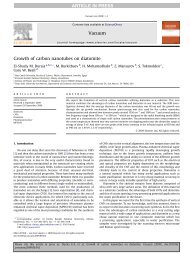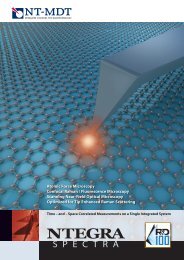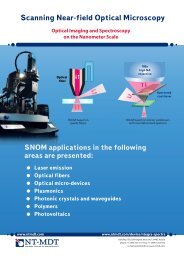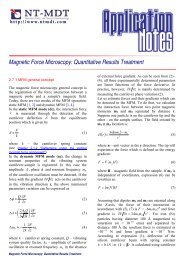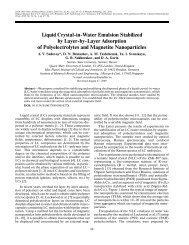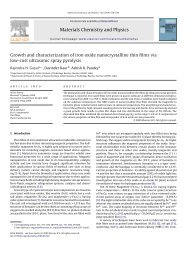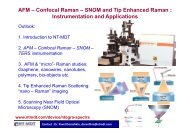Magnetic properties of (Co/Au)N multilayers with ... - Materials Science
Magnetic properties of (Co/Au)N multilayers with ... - Materials Science
Magnetic properties of (Co/Au)N multilayers with ... - Materials Science
You also want an ePaper? Increase the reach of your titles
YUMPU automatically turns print PDFs into web optimized ePapers that Google loves.
<strong>Materials</strong> <strong>Science</strong>-Poland, Vol. 25, No. 4, 2007<strong>Magnetic</strong> <strong>properties</strong> <strong>of</strong> (<strong>Co</strong>/<strong>Au</strong>) N <strong>multilayers</strong><strong>with</strong> various numbers <strong>of</strong> repetition N *P. MAZALSKI 1 , I. SVEKLO 1 , M. TEKIELAK 1** , A. KOLENDO 1 ,A. MAZIEWSKI 1 , P. KUŚWIK 2 , B. SZYMAŃSKI 2 , F. STOBIECKI 21 Institute <strong>of</strong> Experimental Physics, University <strong>of</strong> Białystok, Lipowa 41, 15-424 Białystok, Poland2 Institute <strong>of</strong> Molecular Physics, Polish Academy <strong>of</strong> <strong>Science</strong>s,Smoluchowskiego 17, 60-179 Poznań, PolandMagnetization reversal processes and magnetic domain structures have been studied in multilayeredsystems consisting <strong>of</strong> magnetostatically coupled cobalt layers separated by non-magnetic/s<strong>of</strong>t-magneticones. Observations <strong>of</strong> the domain structures have been performed at room temperature using Kerr microscopyand magnetic force microscopy technique. The studies have been focused on the key characteristics<strong>of</strong> magnetic hysteresis loops as well as the domain structures and domain periods in such systems.Key words: <strong>multilayers</strong>; ultrathin film; cobalt; domain structure; hysteresis loop1. Introduction<strong>Magnetic</strong> <strong>multilayers</strong> have been the subject <strong>of</strong> intensive research. Interest in suchsystems has grown rapidly, being motivated by the search <strong>of</strong> new magnetic materials,their novel magnetic <strong>properties</strong> and applications. Properties <strong>of</strong> magnetic <strong>multilayers</strong>can be easily manipulated by varying the thickness <strong>of</strong> both the magnetic and non-magneticlayers as well as by varying the number <strong>of</strong> layers [1–3]. It is known that in magnetic<strong>multilayers</strong> <strong>with</strong> perpendicular anisotropy, the saturation field <strong>of</strong> stripe domainsexhibits a non-trivial dependence on the thickness <strong>of</strong> non-magnetic spacing [4]. Influence<strong>of</strong> ultrathin film thickness on the size <strong>of</strong> domain structure has been recently described[5].In the paper, the influence <strong>of</strong> <strong>Co</strong> and <strong>Au</strong> layer thicknesses as well as the number<strong>of</strong> repetitions N on the magnetic <strong>properties</strong> <strong>of</strong> <strong>Co</strong>/<strong>Au</strong> <strong>multilayers</strong> has been presented.__________* Presented at the <strong>Co</strong>nference <strong>of</strong> the Scientific Network “New <strong>Materials</strong> for Magnetoelectronics– MAG-EL-MAT 2007”, Będlewo near Poznań, 7–10 May 2007.** <strong>Co</strong>rresponding author, e-mail: tekmar@uwb.edu.pl
1290P. MAZALSKI et al.2. Samples and experimentA few series <strong>of</strong> [<strong>Co</strong>/<strong>Au</strong>] N and [Py/<strong>Au</strong>/<strong>Co</strong>/<strong>Au</strong>] N (Py = Ni 80 Fe 20 ) magnetic <strong>multilayers</strong>were deposited by dc magnetron sputtering in UHV conditions on an oxidized siliconsubstrate <strong>with</strong> the following structure:• buffers – either <strong>Au</strong> (5 nm) or [Py (2 nm)/<strong>Au</strong> (2 nm)] 10 ,• <strong>multilayers</strong> – either [<strong>Co</strong> (d <strong>Co</strong> )/<strong>Au</strong> (d <strong>Au</strong> )] N or [Py (2 nm)/<strong>Au</strong> (d <strong>Au</strong> )/<strong>Co</strong> (d <strong>Co</strong> )/<strong>Au</strong> (d <strong>Au</strong> )] N ,<strong>with</strong> d <strong>Co</strong> = 0.6–1.5 nm, d <strong>Au</strong> = 1.5 nm, 3 nm, and N = 1–15.Sample composition was controlled by the XRF technique. Such specific types <strong>of</strong>structures were produced in order to examine the influence <strong>of</strong> magnetic (<strong>Co</strong>), nonmagnetic(<strong>Au</strong>) and s<strong>of</strong>t magnetic (Py) layers on the magnetic <strong>properties</strong> <strong>of</strong> nanostructuresand their domain structures. All magnetic measurements in multilayer sampleswere done ex-situ at room temperature using the following techniques: magnetoopticalKerr effect (MOKE) for magnetic domain structure visualization, magnetoopticalmillimagnetometry for recording hysteresis curves as a function <strong>of</strong> magneticfield applied perpendicularly to the sample plane and atomic and magnetic force microscopy(AFM/MFM) for both surface structure and magnetic domain structure imagingbeyond the optical resolution. The study <strong>of</strong> magnetization reversal was performedusing a MOKE-based magnetometer <strong>with</strong> the laser wavelength <strong>of</strong> 640 nm anda spot diameter <strong>of</strong> 0.5 mm. The polar magnetization component was measured as afunction <strong>of</strong> the sweeping magnetic field. The LabView program controlled the measurements<strong>of</strong> the hysteresis loop and in real-time calculated saturation, remanence andthe coercive field.<strong>Magnetic</strong> domain structure was visualized using the polar Kerr effect. A CarlZeiss Jenapol optical polarizing microscope <strong>with</strong> xenon lamp illumination wasequipped <strong>with</strong> a high sensitivity camera <strong>with</strong> a cooled CCD element and a computercontrolled frame grabber. The video signal was electronically processed, subsequentlydigitized, and then improved by standard image processing techniques (including subtractingthe reference image). A computer controlled set-up enabled the adjustment <strong>of</strong>image acquisition time as well as the generation <strong>of</strong> pulses <strong>of</strong> magnetic field orientedperpendicularly to the film plane and characterized by the duration <strong>of</strong> amplitude andtime. The images presented in the paper were acquired in a zero magnetic field. Thefollowing procedure was used for magnetic domain generation and visualization: thesample was saturated in magnetic field, then the field was reduced to zero and thereference image I R recorded. A magnetic field pulse in the opposite direction <strong>with</strong> theamplitude smaller than saturation was applied and the domain structure image I recorded.The final resulting image was calculated as the difference between the domainstructure image I and the reference image I R .The MFM technique was used for imaging the magnetic structures beyond the opticalresolution [6, 7]. In our case, an NT-MDT NTEGRA system equipped <strong>with</strong> lowmagnetic moment MFM tips (MESP-LM, Veeco) was used. A tapping/lift modeenables obtaining <strong>of</strong> both the topography and the map <strong>of</strong> magnetic interaction betweenthe sample and a tip.
1292P. MAZALSKI et al.Fig. 2. MOKE hysteresis loops and MFM magneticdomain structure images recorded in samples[Py (2 nm)/<strong>Au</strong> (2 nm)] 10 /[<strong>Co</strong>(d <strong>Co</strong> )/<strong>Au</strong> (1.5 nm)] 15 :a) d <strong>Co</strong> = 0.6 nm, b) d <strong>Co</strong> = 1.0 nm, c) d <strong>Co</strong> = 1.5 nm.Image sizes are 10×10 μm 2Figure 3 shows magnetic hysteresis loops and domain structure images depending onthe non-magnetic <strong>Au</strong> layer thickness d <strong>Au</strong> for the fixed magnetic layer thickness d <strong>Co</strong> = 1.5nm. The magnetic domain structure period increases versus non-magnetic layer thickness.This is connected <strong>with</strong> the decrease <strong>of</strong> magnetostatic forces (a decrease in magnetostaticcoupling) connected <strong>with</strong> d <strong>Au</strong> increase. Multilayers <strong>with</strong> d <strong>Co</strong> = 0.6 nm and d <strong>Co</strong> = 1.0 nmexhibit a similar evolution <strong>with</strong> the increase <strong>of</strong> the gold layer thickness.Fig. 3. Domain structure images and MOKEhysteresis loops in samples<strong>Au</strong> (5 nm)/([<strong>Co</strong> (1.5 nm)/<strong>Au</strong>(d <strong>Au</strong> )] 15for various <strong>Au</strong> layer thicknesses: a) d <strong>Au</strong> = 1.5 nm,b) d <strong>Au</strong> = 3.0 nm. Image sizes are 5×5 μm 2One can find a significant influence <strong>of</strong> the permalloy layer on domain patternsand magnetization processes (Figs. 1, 4). Introduction <strong>of</strong> Py layers leads to screening<strong>of</strong> the magnetic field from adjacent <strong>Co</strong> layers and to the increase <strong>of</strong> the spacer thick-
<strong>Magnetic</strong> <strong>properties</strong> <strong>of</strong> (<strong>Co</strong>/<strong>Au</strong>) N <strong>multilayers</strong> 1293ness. Because the magnetostatic coupling between <strong>Co</strong> layers is weaker, magnetizationreversal occurs more independently in a particular layer. This effect is visible inFig. 4a and b, as domains <strong>with</strong> multiple shades <strong>of</strong> gray or in multi-jumps in hysteresisloops. A similar magnetization reversal was observed in [9] for <strong>Co</strong>/Pt multilayer.Fig. 4. Domain patterns and corresponding magnetooptic hysteresis loops recorded for[Py (2 nm)/<strong>Au</strong> (1.5 nm)/<strong>Co</strong> (0.6 nm)/<strong>Au</strong> (1.5 nm)] N for various repetitions numbers: a),d) N = 3, b), e) N = 6, c), f) N = 15. Images sizes are: a), b) 400×400 μm 2 , c) 15×15 μm 2MFM measurements in an external magnetic field applied perpendicular to thesample plane (Fig. 5) demonstrate that the magnetization process goes through domainwall motion. Bubble domain structure was observed while approaching saturationfield (Fig. 5c).Fig. 5. Evolution <strong>of</strong> magnetic domain structure in external magnetic fieldapplied perpendicular to the sample plane for <strong>Au</strong> (5 nm)/[<strong>Co</strong> (1 nm)/<strong>Au</strong> (1.5 nm)] 15 :a) H = 0 Oe, b) H = 1.5 kOe, c) H = 2.1 kOe recorded <strong>with</strong> MFM. Scan size is 5×5 μm 24. <strong>Co</strong>nclusionWe have studied the magnetic <strong>properties</strong> and magnetic domain structures <strong>of</strong>[<strong>Co</strong>/<strong>Au</strong>] N and [Py/<strong>Au</strong>/<strong>Co</strong>/<strong>Au</strong>] N <strong>multilayers</strong> grown <strong>with</strong> various numbers <strong>of</strong> repetition
1294P. MAZALSKI et al.N on different thicknesses <strong>of</strong> magnetic (<strong>Co</strong>), non-magnetic (<strong>Au</strong>) and s<strong>of</strong>t–magnetic(Py) layers. All the analyzed <strong>multilayers</strong> display a decreased period <strong>of</strong> magnetic domainstructure as the cobalt layer thickness grows, a decreased magnetic domain structureperiod <strong>with</strong> the increase number <strong>of</strong> repetition N and an increased domain structureperiod versus non-magnetic layer thickness.AcknowledgementsThis work was supported by the Marie Curie Fellowships for “Transfer <strong>of</strong> Knowledge” (“NANO-MAG-LAB” N 2004-003177).References[1] BARNES J.R., O’SHEA S.J., WELLAND M.E., KIM J.Y., EVETTS J.E., SOMEKH R.E., J. Appl. Phys., 76(1994), 2974.[2] DONZELLI O., PALMERI D., MUSA L., CASOLI F., ALBERTINI F., PARETI L., TURILLI G., J. Appl. Phys.,93, (2003), 9908.[3] BELLIARD L., MILTAT J., KOTTLER V., MATHET V., CHAPPERT C., VALET T., J. Appl. Phys., 81 (1997), 8.[4] DRAAISMA H.J.G., DE JONGE W.J.M., J. Appl. Phys., 62 (1987), 3318.[5] KISIELEWSKI M., MAZIEWSKI A., POLYAKOVA T., ZABLOTSKII V., Phys. Rev. B 69 (2004), 184419 andreferences therein.[6] ZHU X., GRÜTTER P., MRS Bull., 29 (2004), No. 7.[7] HOPSTER H., OEPEN H.P., <strong>Magnetic</strong> Microscopy <strong>of</strong> Nanostructures, Springer, Berlin, 2005.[8] FERRE J., GROLIER V., MEYER P., MAZIEWSKI A., STEFANOWICZ E., TARASENKO S.V., TARASENKO V.V.,KISIELEWSKI M., RENARD D., Phys. Rev. B, 55 (1997), 15092.[9] ROBINSON M., AU Y., KNEPPER J.W., YANG F.Y., SOORYAKUMAR R., Phys Rev. B, 73 (2006), 224422.Received 10 May 2007Revised 6 <strong>Au</strong>gust 2007



